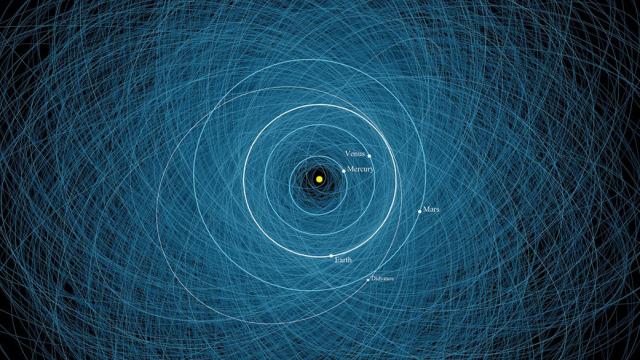A new asteroid impact monitoring system called Sentry-II is powerful, fast, and capable of handling difficult scenarios that continually baffled its predecessor.
NASA JPL’s Centre for Near Earth Object Studies (CNEOS) has been using the pre-existing monitoring system, called Sentry, to evaluate asteroid impact risks since 2002. Javier Roa Vicens, a former NASA navigation engineer who now works at SpaceX, said that, in under an hour, Sentry “could reliably get the impact probability for a newly discovered asteroid over the next 100 years — an incredible feat,” as he explained in a NASA press release.
That’s impressive, no doubt, but the time has come for an upgrade, and with all due respect to Sentry, the newly deployed system, appropriately called Sentry-II, is damned impressive. Roa Vicens, along with Davide Farnocchia, both researchers at CNEOS, detail the new system in a paper published in The Astronomical Journal.
Asteroids have highly predictable orbits that are subject to slight perturbations over vast timescales, making them, um, not as highly predictable as we’d like them to be. This leads to uncertainties and unreasonably large impact probability windows. Simply put, Sentry-II, with its new-fangled impact monitoring software, is better at evaluating these uncertainties, and is thus superior at evaluating threats posed by near Earth objects, or NEOs. Now online, Sentry-II will predict impact probabilities for NASA’s Planetary Defence Coordination Office (PDCO).
Another cool thing about Sentry-II is that it can process special cases that befuddled Sentry (more on this in just a bit), and it does so in rapid fashion for all previously known and newly discovered NEOs. The system is expected to handle the expected influx of newly discovered asteroids in the coming years (NASA is currently tracking 28,000 NEOs and around 3,000 are being added to the list each year), and, perhaps most importantly, it can detect the smallest impact odds for a much wider range of uncertainty scenarios. Indeed, Sentry-II eats probabilities for breakfast, as it’s capable of calculating “impact odds as low as a few chances in 10 million,” according to NASA. Importantly, the system automatically reports the most dangerous objects to the CNEOS Sentry Table — a list showing the most dangerous NEOs.
So those special cases I was talking about — there’s two in particular. The original Sentry really struggled when it came to calculating the minute changes in an asteroid’s trajectory following super close flybys with Earth, requiring manual interventions in some cases. As NASA points out, “Sentry-II doesn’t have that limitation.” Excitingly, Sentry-II can even account for the Yarkovsky effect. Asteroids can absorb solar radiation, but this radiation eventually leaks away, resulting in the thruster-like Yarkovsky effect, which can influence the orbital path of asteroids over timescales of decades and centuries.
“The fact that Sentry couldn’t automatically handle the Yarkovsky effect was a limitation,” Farnocchia said in the press release. “Every time we came across a special case — like asteroids Apophis, Bennu, or 1950 DA — we had to do complex and time-consuming manual analyses. With Sentry-II, we don’t have to do that anymore.”
Ultimately, Sentry-II means we stand a better chance of evaluating threats posed by NEOs, which will in turn allow us to respond to those threats. But as Farnocchia explained in an email, the chance of an asteroid impact that would cause significant damage is low.
“Still, once an asteroid is discovered we want to be able to promptly establish if a future impact is a possibility,” he told Gizmodo. “The old Sentry has performed this task remarkably well over the last 20 years, and we now have an even more reliable system, so the implementation of Sentry-II is good news in terms of planetary defence.”
Should a dangerous NEO be detected, there’s not much that we can do right now aside from evacuating threatened areas on Earth. NASA’s recently launched Double Asteroid Redirect Test (DART) mission, in which the space agency will try to deflect a tiny asteroid named Dimorphos, could be the first big step in developing a potential civilisation-saving protective shield.
More: 9 Things to Know About NASA’s Armageddon Mission to Deflect an Asteroid.
